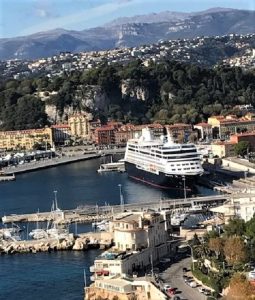 One of the advantages of our back-to-back cruises was the fact that we remained on the same ship, in the very same stateroom, and did not have to go through the agonizing ritual of packing and unpacking.
One of the advantages of our back-to-back cruises was the fact that we remained on the same ship, in the very same stateroom, and did not have to go through the agonizing ritual of packing and unpacking.
Our second cruise (November 21-30, 2021) included 9-nights, which began in Rome and then made port in Nice, France; Barcelona, Valencia & Cartagena, Spain; Gibraltar, United Kingdom; and ended in Lisbon, Portugal.
There were a few more passengers on board for this cruise – 147 as opposed to the 109 on our first outing – but since the ship would accommodate up to 690 and there were still 408 members of the crew onboard ready to serve, the ratio was solidly in our favor and the service remained nothing short of impeccable. The only difference seemed to be that this was a slightly younger (and livelier) crowd than we had encountered on the first cruise.
Livorno, Italy: There were a number shore excursions open to us… but the thought of a leisurely jaunt through the picturesque Tuscan countryside, ending with a tour and tasting at a local winery, sounded like the perfect afternoon outing. The countryside was, indeed picturesque… ditto the winery, which, for reasons I will note later, shall remain nameless.
 We had a look at the vineyard (pictured) and then strolled up a tree-lined drive to the winery proper. We spent a good deal of time in the cellar, listening to the estate’s sommelier discuss local wine-making and methods of production. From there, of course, it was upstairs to the wine tasting, obviously designed to be the highlight of the excursion; ultimately, however, a major disappointment.
We had a look at the vineyard (pictured) and then strolled up a tree-lined drive to the winery proper. We spent a good deal of time in the cellar, listening to the estate’s sommelier discuss local wine-making and methods of production. From there, of course, it was upstairs to the wine tasting, obviously designed to be the highlight of the excursion; ultimately, however, a major disappointment.
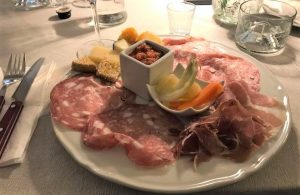 And the tip off was clearly the pile of comestibles placed before us (pictured). During a tasting, you always want a bit of food to purge the palate between sips of different kinds of wine. We were a table of six persons (three couples), so the plate of food pictured would have been more than adequate to supply us all with sufficient palate-cleansing pleasure… But this was the size of the plate placed before each of us… Clearly a case of gastronomic overkill. Perhaps the thinking was that if we had enough food to keep us occupied, we wouldn’t notice that the wines were eminently forgettable.
And the tip off was clearly the pile of comestibles placed before us (pictured). During a tasting, you always want a bit of food to purge the palate between sips of different kinds of wine. We were a table of six persons (three couples), so the plate of food pictured would have been more than adequate to supply us all with sufficient palate-cleansing pleasure… But this was the size of the plate placed before each of us… Clearly a case of gastronomic overkill. Perhaps the thinking was that if we had enough food to keep us occupied, we wouldn’t notice that the wines were eminently forgettable.
Nice, France: Our excursion took us on a driving exploration that captured all the marvelous grandeur that is the French Riviera. Following the Corniche roadways higher and higher into the mountains, each turn seemed to present yet another spectacular perspective of the cliff-lined coast and the ruggedly beautiful countryside. The photograph at the beginning of this article, for example – our ship docked in the port of Nice – was taken from the roadway above the city.
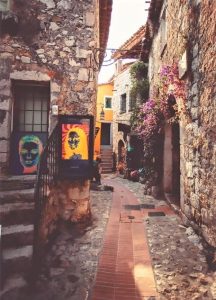 The ultimate destination of our excursion was the beautiful hilltop medieval village of Èze, located between Monaco and Nice. Famous for its beauty, charm, impressive architecture, and spectacular view of the sea, the small village also has numerous shops, art galleries, hotels, and restaurants, attracting an annual invasion of tourists and honeymooners. So popular has it become that it is often referred to as the village-musée, “museum village,” as few locals actually reside there. Èze is one of sixteen villages grouped together by Métropole Nice Côte d’Azur tourist department as Route des Villages Perchés (Route of Perched Villages).
The ultimate destination of our excursion was the beautiful hilltop medieval village of Èze, located between Monaco and Nice. Famous for its beauty, charm, impressive architecture, and spectacular view of the sea, the small village also has numerous shops, art galleries, hotels, and restaurants, attracting an annual invasion of tourists and honeymooners. So popular has it become that it is often referred to as the village-musée, “museum village,” as few locals actually reside there. Èze is one of sixteen villages grouped together by Métropole Nice Côte d’Azur tourist department as Route des Villages Perchés (Route of Perched Villages).
At the top of the hill above the village is the one attraction that simply cannot be missed: the Jardin Exotique d’ Èze, the Exotic Garden of Èze. Planted on the site of an ancient fortress 1,407 feet above sea level, the garden was developed during the Second World War by Andre Gianton, then mayor of Èze, with the assistance of Jean Gastaud, who also created the Exotic Garden of Monaco just a few kilometers away.
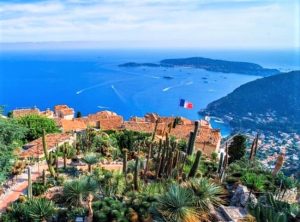 Its position at the top of the steep village meant that soil and rocks used to create the garden and its terraces had to be carried manually, as well as the cacti and succulents. The plants ranged from young plants to mature specimens, including a crown of thorns weighing half a ton. Adding to the charm, there are a number of statues, female figures made of clay or bronze, by Jean-Phillipe Richard.
Its position at the top of the steep village meant that soil and rocks used to create the garden and its terraces had to be carried manually, as well as the cacti and succulents. The plants ranged from young plants to mature specimens, including a crown of thorns weighing half a ton. Adding to the charm, there are a number of statues, female figures made of clay or bronze, by Jean-Phillipe Richard.
Above all, the garden offers an unforgettable view of the Côte d’Azur (pictured). It was this view that philosopher Friedrich Nietsche admired while creating his most important work, Thus Spoke Zarathustra.
Nice itself also has a number of points of interest. Among the most fascinating – at least to this writer – is the iconic Le Negresco hotel (pictured). Located on the Promenade des Anglais, the magnificent belle-époque building is instantly recognizable by its pink domed roof.
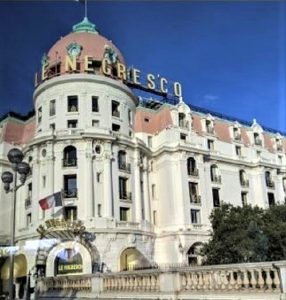 Le Negresco, which celebrated its centennial in 2013, is comparable to a grand museum, with five centuries of French history represented in its art and furnishings. Portraits of kings and queens are displayed side-by-side with the works of contemporary artists such as Sosno, Dalí, Gruau, Moretti, and Nike de Saint Phalle. The hotel also boasts an impressive stained-glass dome designed by Gustave Eiffel, a double Michelin-starred restaurant, Chantecler, and a chandelier commissioned by Tsar Nicholas II.
Le Negresco, which celebrated its centennial in 2013, is comparable to a grand museum, with five centuries of French history represented in its art and furnishings. Portraits of kings and queens are displayed side-by-side with the works of contemporary artists such as Sosno, Dalí, Gruau, Moretti, and Nike de Saint Phalle. The hotel also boasts an impressive stained-glass dome designed by Gustave Eiffel, a double Michelin-starred restaurant, Chantecler, and a chandelier commissioned by Tsar Nicholas II.
… And for those who may be interested, Le Negresco was also mentioned in two James Bond novels. Bond stayed at the hotel in the John Gardner’s License Renewed and dined here in his Role of Honor. The hotel has also appeared in a number of movies. Perhaps the most well-known is the 1973 Anglo-French thriller The Day of the Jackal. Protagonist Edward Fox (the Jackal) drives along the picturesque Promenade des Anglais with a lingering shot of the prominent dome of Le Negresco in the background. Director Fred Zinnemann also treated filmgoers to a rare interior view when the Jackal walked into the palatial hotel to use the telephone.
Barcelona, Spain: As I mentioned at the outset of this article, one of the advantages of having so few passengers on board is that the quality of service tends to be outstanding… But there are disadvantages as well. The major disadvantage, in my opinion, is that there may not be a sufficient number of people to fill certain shore excursions in which you may have an interest… If that is the case, those excursions will simply be canceled and you are out of luck. This happened to us several times during our two cruises. In Barcelona, for example, I was particularly interested in the Discover Picasso excursion, a guided tour to the locations that were significant to Picasso’s development and work, concluding with a visit to the Picasso Museum. No dice. Canceled for lack of signups.
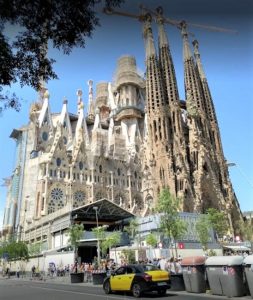 The excursion of interest to all, of course, was the tour to several of the architectural creations of Antonio Gaudi, culminating with a visit to his unfinished grand masterpiece, Sagrada Familia, Holy Family Cathedral (pictured).
The excursion of interest to all, of course, was the tour to several of the architectural creations of Antonio Gaudi, culminating with a visit to his unfinished grand masterpiece, Sagrada Familia, Holy Family Cathedral (pictured).
An icon of the city of Barcelona, and among Spain’s most visited tourist sites, the basilica is famous for its wildly creative, unmistakably organic architecture and décor, both inside and out. The exterior is breathtaking, to say the least; the interior – filled with stained glass inset in a cavernous, colonnaded hall that rises dramatically upward – almost otherworldly. Gaudi envisioned the cathedral as a structure that would present the life of Christ over the course of 18 spires. When completed, it is expected to be the tallest cathedral in the world.
Construction of the Sagrada Familia began in 1882. Since that time, it has been interrupted only once, during the Spanish Civil War in the 1930s. When Gaudi died in 1926, not even a quarter of the cathedral had been built. The original plan to have the construction completed by 2026 to mark the 100th anniversary of Gaudi’s death was recently set aside, attributable to the effects of the pandemic on cathedral funding.
I vividly remember entering the Cologne Cathedral in Germany for the first time and being simply overwhelmed by, for want of the better phrase, a “sense of the Holy.” Even though there were quite a few people visiting that day, there was a subdued hush to conversations, as the building itself inspired respectful silence and worship. Interestingly enough, entering Sagrada Familia, the feeling was totally different. People – from groups of schoolchildren, to hordes of foreign tourists, to women walking toddlers & pushing strollers – were more matter-of-fact and less respectful of their surroundings; the general atmosphere infinitely more “touristic.”
Gaudi’s cathedral certainly inspires awe; but for me, personally, it does not inspire worship. Whether it was the hordes of tourists or the “otherworldliness” of the building itself – or both – I cannot be sure… I just know that the “sense of the Holy” seemed strangely conspicuous by its absence. Perhaps there can, indeed, be too much of a good thing.
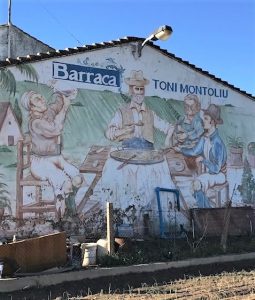 Valencia, Spain: Our excursion here was a particularly enjoyable one. We journeyed out of the city to a traditional Valencian barraca (farmhouse). Our host, owner Toni Montoliu, took us on a tour of his farm, where we picked fresh vegetables and participated in the making of Paella, a rice dish that originated in Valencia and is one of the best-known dishes in Spanish cuisine.
Valencia, Spain: Our excursion here was a particularly enjoyable one. We journeyed out of the city to a traditional Valencian barraca (farmhouse). Our host, owner Toni Montoliu, took us on a tour of his farm, where we picked fresh vegetables and participated in the making of Paella, a rice dish that originated in Valencia and is one of the best-known dishes in Spanish cuisine.
Paella takes its name from the wide, shallow traditional pan used to cook the dish on an open fire. As a dish, it may have ancient roots; but, in its modern form, it is traced back to the mid-19th century in the rural area around the Albufera lagoon adjacent to the city of Valencia on the Mediterranean coast of Spain.
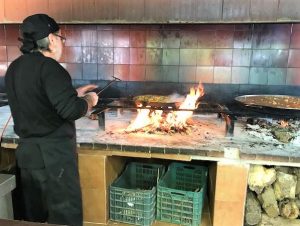 Paella Valenciana is the traditional paella of the Valencia region and believed to be the original recipe for this dish. Early on, paella made in Valencia was a lunchtime meal for farmers and farm laborers. Workers would gather what was available to them around the rice fields. In addition to round grain rice, this could also include tomatoes, onions, snails, and varieties of green beans. Rabbit or duck was a common addition, chicken less often (Toni noted that his usual version included rabbit & duck, but that he had substituted chicken, which he thought would be more appealing to his guests).
Paella Valenciana is the traditional paella of the Valencia region and believed to be the original recipe for this dish. Early on, paella made in Valencia was a lunchtime meal for farmers and farm laborers. Workers would gather what was available to them around the rice fields. In addition to round grain rice, this could also include tomatoes, onions, snails, and varieties of green beans. Rabbit or duck was a common addition, chicken less often (Toni noted that his usual version included rabbit & duck, but that he had substituted chicken, which he thought would be more appealing to his guests).
Paella is cooked in olive oil and chicken broth and seasoned with rosemary (sometimes whole branches). Traditionally its yellow color comes from saffron, but turmeric and calendula are sometimes substituted. (Pictured: Toni, the master at work)
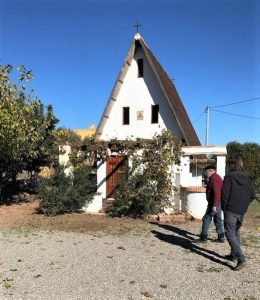 But even before Toni got down to the business of cooking, he took the time to escort us on a horse-drawn carriage ride through his farm to the house where he was born and grew up. Tucked away next to a dirt road at what seemed to be the epicenter of the fields, the house (pictured) was surprisingly tiny. While we checked out the quaint interior, Toni shared some stories (translated by our guide) about life on a typical Spanish farm, and the experiences of growing up in such a demanding environment.
But even before Toni got down to the business of cooking, he took the time to escort us on a horse-drawn carriage ride through his farm to the house where he was born and grew up. Tucked away next to a dirt road at what seemed to be the epicenter of the fields, the house (pictured) was surprisingly tiny. While we checked out the quaint interior, Toni shared some stories (translated by our guide) about life on a typical Spanish farm, and the experiences of growing up in such a demanding environment.
 The highlight of our excursion was, of course, when we finally had opportunity to sit down at table and sample Toni’s cuisine. Which, I might add, was infinitely more than expected. For not only did we dig into the Paella, but also a fabulous salad to start, sides of addictive garlic bread, potatoes, artichoke hearts, and freshly picked oranges for dessert. And, I should add, local wine – which was very good, by the way – flowed freely.
The highlight of our excursion was, of course, when we finally had opportunity to sit down at table and sample Toni’s cuisine. Which, I might add, was infinitely more than expected. For not only did we dig into the Paella, but also a fabulous salad to start, sides of addictive garlic bread, potatoes, artichoke hearts, and freshly picked oranges for dessert. And, I should add, local wine – which was very good, by the way – flowed freely.
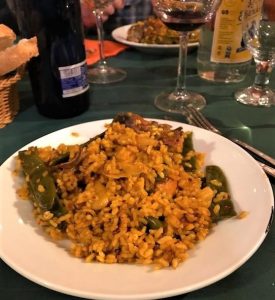 Portions were more than generous, as you can see by the amount of food that had been piled on participants’ plates. And, across the board, everything we tasted was absolutely delicious. There is something immensely satisfying about dining at the source, literally harvesting your food and then, even in some small way, participating in its preparation.
Portions were more than generous, as you can see by the amount of food that had been piled on participants’ plates. And, across the board, everything we tasted was absolutely delicious. There is something immensely satisfying about dining at the source, literally harvesting your food and then, even in some small way, participating in its preparation.
Toni was the ultimate host; and our guide did a marvelous job of translating his words of hospitality and comments about the food and wine. A good time was had by all. After such an extravagant lunch, when we returned to the ship, a very light evening meal was very much in order.
Gibraltar, United Kingdom: Gibraltar is a British Overseas Territory (one of the fourteen territories with a constitutional and historical link with the United Kingdom) located at the southern tip of the Iberian Peninsula. Encompassing an area of 2.6 square miles, it is bordered to the north by Spain.
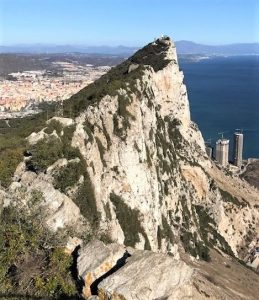 Our excursion took us on a van ride through the city of Gibraltar and for a stroll through the beautiful Alameda Gardens. The highlight, however, was our cable car ride and visit to the top of the Rock of Gibraltar, the breathtaking 1,398 ft. high monolithic limestone promontory. The views from the top of the Rock are, indeed, spectacular: the city of Gibraltar to the west; the coastline of Africa to the south; the Spanish mainland to the north; and the waters of the Mediterranean to the east.
Our excursion took us on a van ride through the city of Gibraltar and for a stroll through the beautiful Alameda Gardens. The highlight, however, was our cable car ride and visit to the top of the Rock of Gibraltar, the breathtaking 1,398 ft. high monolithic limestone promontory. The views from the top of the Rock are, indeed, spectacular: the city of Gibraltar to the west; the coastline of Africa to the south; the Spanish mainland to the north; and the waters of the Mediterranean to the east.
According to Greek mythology, the Rock of Gibraltar, known to the Romans as Mons Calpe, was thought to be one of the two traditional Pillars of Hercules, the other being either Monte Hacho or Jebel Musa on the African side of the strait. According to ancient myths, the two points marked the limit to the known world.
Most of the Rock’s upper area is covered by a nature reserve, which is home to approximately 300 Barbary macaques (monkeys). Originally from the Atlas Mountains and the Rif Mountains of Morocco, the Barbary macaque population in Gibraltar is the only wild monkey population on the European continent.
The macaques are a major tourist attraction – and problem… They roam freely, especially in areas near the cable car and various observation terraces. Yes, they are cute and cuddly. But they are still wild animals… And we were cautioned early on – and on several occasions – to keep a tight grip on all our belongings, as these cunning little creatures steal with impunity.
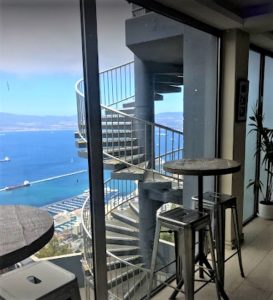 Following our tour of the Top of the Rock, before descending in the cable car, my traveling companion and I stopped for a relaxing libation in the Mons Calpe Suite. Located within the cable car top station, this attractive restaurant/bar offers visitors brunch, lunch, cocktails, and also serves groups afternoon tea.
Following our tour of the Top of the Rock, before descending in the cable car, my traveling companion and I stopped for a relaxing libation in the Mons Calpe Suite. Located within the cable car top station, this attractive restaurant/bar offers visitors brunch, lunch, cocktails, and also serves groups afternoon tea.
The atmosphere here is pleasant, relaxing, surprisingly un-touristy; and the view, of course, is magnificent (pictured: Yes, I think that was our table 😊). My only regret, once again, is that we did not have opportunity to sample the food here. It ranges from items like Oxtail Lasagna & Galatian Beef Cheeseburger to Classic Fish & Chips, has garnered excellent reviews, and is quite reasonably priced. The restaurant also boasts an impressive list of innovative cocktails and varied selection of wines. After an exciting day of sightseeing, Mons Calpe Suite is a great place to unwind.
Lisbon, Portugal: The final excursion of our cruise was Lisbon by Tuk Tuk. A tuk tuk is open-air three-wheeled electric vehicle similar to a golf cart. A motorized relative of the rickshaw, the tuk tuk was invented in Thailand some fifty years and was given its name because the rough engine sound made by early models.
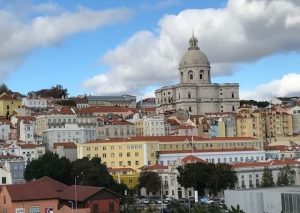 Extending over seven steep hills, Lisbon is a fascinating city… And a tuk tuk is a great way to take it in, especially on such a delightfully warm sunny day (Pictured: Cityscape of Lisbon with Dome of Panteao Nacional, National Pantheon, formerly the Church of Santa Engrácia).
Extending over seven steep hills, Lisbon is a fascinating city… And a tuk tuk is a great way to take it in, especially on such a delightfully warm sunny day (Pictured: Cityscape of Lisbon with Dome of Panteao Nacional, National Pantheon, formerly the Church of Santa Engrácia).
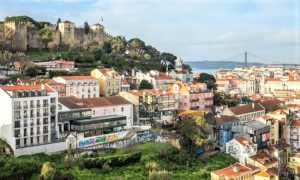 We made our way through a series narrow uphill streets and alleyways, finally arriving at the Igreja da Garça, the Church and Convent of our Lady of Grace, in Garça, one of the ancient sections of Lisbon. Here on the terrace, beneath the shade of parasol pines, tourists and locals alike gather together for drinks served from a kiosk, to listen to the soft sounds of a combo of time-warped musicians straight out of the 60s, and, above all, to take in the stunning view of Saint George’s Castle, the city below, and the 25 de Abril Bridge, 25th of April Bridge.
We made our way through a series narrow uphill streets and alleyways, finally arriving at the Igreja da Garça, the Church and Convent of our Lady of Grace, in Garça, one of the ancient sections of Lisbon. Here on the terrace, beneath the shade of parasol pines, tourists and locals alike gather together for drinks served from a kiosk, to listen to the soft sounds of a combo of time-warped musicians straight out of the 60s, and, above all, to take in the stunning view of Saint George’s Castle, the city below, and the 25 de Abril Bridge, 25th of April Bridge.
Saint George’s Castle can be seen from almost anywhere in the city. Its oldest parts date from the 6th century when it was fortified by the Romans, Visigoths and, eventually the Moors. Portugal’s first king, Afonso Henriques, captured it in 1147 with the help of northern European crusaders on their way to the Holy Land. It was later dedicated to Saint George, the patron saint of England, commemorating the Anglo-Portuguese pack dating from 1371. Most of the castle was destroyed over the years, especially in the Great Earthquake of 1755, but it still includes a long extension of walls and 18 towers that were restored in the early 20th century. The towers and ramparts provide breathtaking views of Lisbon, and the beautiful gardens are home to a variety of peacocks, geese, and ducks.
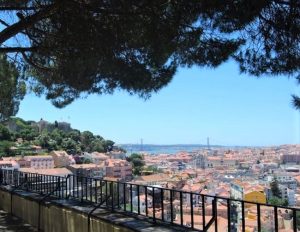 The 25th of April Bridge (seen in the distance in both photographs) is a suspension bridge connecting the city of Lisbon to the municipality of Almada on the south bank of the Tagus River. It has a length of 7,470 ft., making it the 43rd longest suspension bridge in the world. From its inauguration on August 6, 1966, until 1974, it was named Ponte Salazar, Salazar Bridge, after Portuguese Prime Minister António de Oliveira Salazar, who ordered its construction. After the Carnation Revolution, which overthrew the remnants of Salazar’s regime, the bridge was renamed for April 25, the date of the revolution.
The 25th of April Bridge (seen in the distance in both photographs) is a suspension bridge connecting the city of Lisbon to the municipality of Almada on the south bank of the Tagus River. It has a length of 7,470 ft., making it the 43rd longest suspension bridge in the world. From its inauguration on August 6, 1966, until 1974, it was named Ponte Salazar, Salazar Bridge, after Portuguese Prime Minister António de Oliveira Salazar, who ordered its construction. After the Carnation Revolution, which overthrew the remnants of Salazar’s regime, the bridge was renamed for April 25, the date of the revolution.
From the Garça district, we tuk-tuked back into the heart of Lisbon’s downtown, passing a variety of historic churches, theaters, upscale shops & boutiques, as well as the famous Rossio Square and picturesque Parque Eduardo VII.
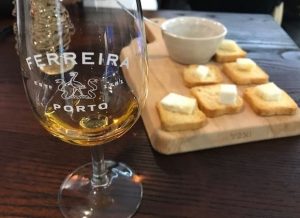 But this excursion wasn’t entirely about sightseeing… Thankfully, there were also two very rewarding pauses for “refreshment” along the way. Our first stop was the Ervideira Wineshop for a brief wine tasting. The shop’s interior was quite modern with racks and racks of various vintages adorning the walls. We were seated at a high-top table in a special room specifically designed for tasting.
But this excursion wasn’t entirely about sightseeing… Thankfully, there were also two very rewarding pauses for “refreshment” along the way. Our first stop was the Ervideira Wineshop for a brief wine tasting. The shop’s interior was quite modern with racks and racks of various vintages adorning the walls. We were seated at a high-top table in a special room specifically designed for tasting.
Our host was very knowledgeable and introduced a number of Portuguese vintages of excellent quality. There was one particular white wine that I undoubtedly would have purchased, had I not been afraid of it bouncing out of our tuk tuk on the way back to the ship. Oh, well.
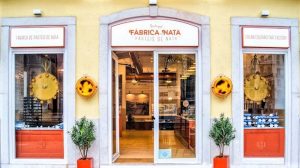 Our second stop was the Fábrica da Nata, a café specializing in Pastéis de Nata, the famous Portuguese custard tarts, which were originally created by Catholic monks at the Mosteiro dos Jerónimos in Lisbon sometime just prior to the 18th century.
Our second stop was the Fábrica da Nata, a café specializing in Pastéis de Nata, the famous Portuguese custard tarts, which were originally created by Catholic monks at the Mosteiro dos Jerónimos in Lisbon sometime just prior to the 18th century.
When it comes to Pastéis de Nata, Fábrica da Nata, is, as one writer put it, very much the new kid in town, as the attractive, bustling café made its debut in the center of Lisbon in March 2016. But it certainly possesses a loyal following; and there are many who believe that its custard tarts are every bit the equal of the iconic Pastéis de Belém.
 The tarts are crunchy and creamy but, thankfully, not too eggy – and downright addictive. There are a number of menus you may order… For example, you can enjoy your Pastel de Nata with a glass of port, if you so desire. But, as far as I’m concerned, coffee is the ideal companion (espresso, however, is even better). The combo is incomparably tasty. And, trust me, it’s difficult (if not impossible) to eat just one.
The tarts are crunchy and creamy but, thankfully, not too eggy – and downright addictive. There are a number of menus you may order… For example, you can enjoy your Pastel de Nata with a glass of port, if you so desire. But, as far as I’m concerned, coffee is the ideal companion (espresso, however, is even better). The combo is incomparably tasty. And, trust me, it’s difficult (if not impossible) to eat just one.
And the prices here are very attractive as well… 1,10 euros per tart. The espresso is 0,70 euros, American coffee, 0,80; tea, 2,00. Then, of course, there are a number of more substantial items that are well worth considering. Like the baguettes, for instance: Tuna, 3,95; Grilled Chicken, 4,10; Serra Cheese & Smoked Ham, 6,00.
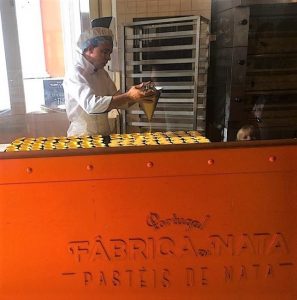 I should mention that fábrica is the Portuguese word for “factory.” That means that not only do you come here to enjoy eating Pastéis de Nata, but also to see how they are made. There is a small glass-enclosed workspace to the left as you enter where the entire creative process takes place, so you can begin salivating even before your sample your first bite. And be sure to check out the automatic railing on the ceiling, as this is how the crunchy pastry cups are transported to be filled with that deliciously silky nata (cream).
I should mention that fábrica is the Portuguese word for “factory.” That means that not only do you come here to enjoy eating Pastéis de Nata, but also to see how they are made. There is a small glass-enclosed workspace to the left as you enter where the entire creative process takes place, so you can begin salivating even before your sample your first bite. And be sure to check out the automatic railing on the ceiling, as this is how the crunchy pastry cups are transported to be filled with that deliciously silky nata (cream).
If you plan to visit Lisbon, Fábrica da Nata is definitely something of a must. And if you’d like a little preview to whet your appetite, be sure to check out https://www.youtube.com/watch?v=iIWzd8gFIVM.
Bon Appétit!
Be Safe & Stay Well
TAD

{ 0 comments… add one now }